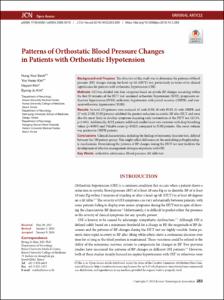Patterns of Orthostatic Blood Pressure Changes in Patients with Orthostatic Hypotension
- Keimyung Author(s)
- Seok, Hung Youl
- Department
- Dept. of Neurology (신경과학)
- Journal Title
- Journal of Clinical Neurology
- Issued Date
- 2018
- Volume
- 14
- Issue
- 3
- Abstract
- Background and Purpose
The objective of this study was to determine the patterns of blood pressure (BP) changes during the head-up tilt (HUT) test, particularly in terms of its clinical significance for patients with orthostatic hypotension (OH).
Methods
OH was divided into four categories based on systolic BP changes occurring within the first 10 minutes of the HUT test: sustained orthostatic hypotension (SOH), progressive orthostatic hypotension (POH), orthostatic hypotension with partial recovery (OHPR), and transient orthostatic hypotension (TOH).
Results
In total, 151 patients were analyzed: 65 with SOH, 38 with POH, 21 with OHPR, and 27 with TOH. POH patients exhibited the greatest reduction in systolic BP after HUT and were also the most likely to develop symptoms requiring early termination of the HUT test (42.1%, p<0.001). Additionally, SOH patients exhibited smaller heart-rate variation with deep breathing values (p=0.003) and Valsalva ratios (p=0.022) compared to POH patients. The sweat volume was greatest in OHPR patients.
Conclusions
Clinical characteristics, including the findings of autonomic function tests, differed between the OH patient groups. This might reflect differences in the underlying pathophysiologic mechanisms. Determining the patterns of BP changes during the HUT test may facilitate the development of effective management strategies in patients with OH.
- Keimyung Author(s)(Kor)
- 석흥열
- Publisher
- School of Medicine (의과대학)
- Citation
- Hung Youl Seok et al. (2018). Patterns of Orthostatic Blood Pressure Changes in Patients with Orthostatic Hypotension. Journal of Clinical Neurology, 14(3), 283–290. doi: 10.3988/jcn.2018.14.3.283
- Type
- Article
- ISSN
- 2005-5013
- Source
- https://www.ncbi.nlm.nih.gov/pmc/articles/PMC6031984/
- Appears in Collections:
- 1. School of Medicine (의과대학) > Dept. of Neurology (신경과학)
- 파일 목록
-
-
Download
 oak-2018-1581.pdf
기타 데이터 / 795.68 kB / Adobe PDF
oak-2018-1581.pdf
기타 데이터 / 795.68 kB / Adobe PDF
-
Items in Repository are protected by copyright, with all rights reserved, unless otherwise indicated.